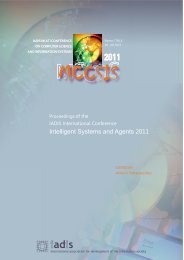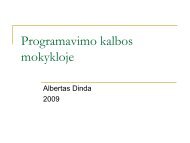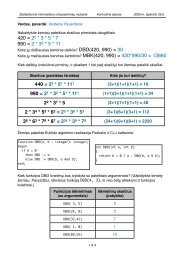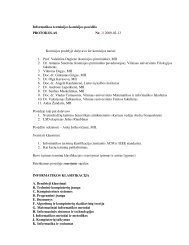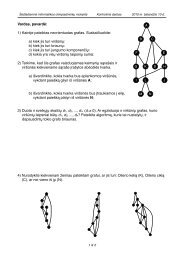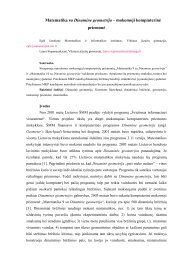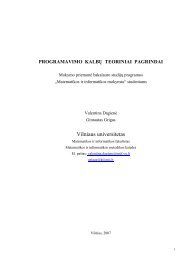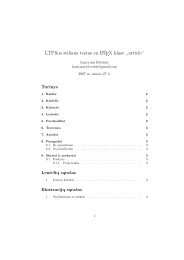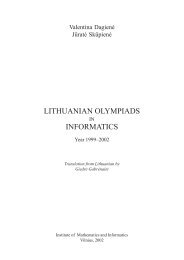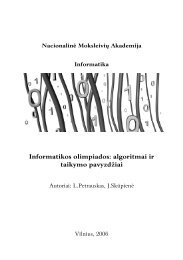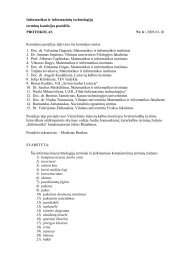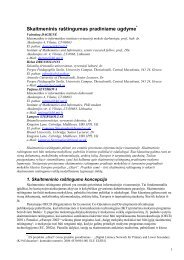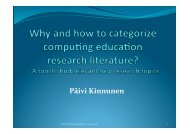Research methods in educational science.pdf
Research methods in educational science.pdf
Research methods in educational science.pdf
You also want an ePaper? Increase the reach of your titles
YUMPU automatically turns print PDFs into web optimized ePapers that Google loves.
Päivi K<strong>in</strong>nunen, PhD University of Eastern F<strong>in</strong>land Filosofical Faculty School of Education and Psychology Paivi.k<strong>in</strong>nunen@uef.fi, pak<strong>in</strong>nunen@gmail.com
Content Characteristic of <strong>educational</strong> <strong>science</strong> research Some research designs Quantitative or qualitative <strong>methods</strong> or mixed-<strong>methods</strong>? Collect<strong>in</strong>g (qualitative) data How to analyze qualitative data? Quality <strong>in</strong> qualitative research Doctoral consortium 1-‐5.12.2011 2
Some characteris/c of educa/onal <strong>science</strong> research Object of the study: students’ understand<strong>in</strong>g/perception of X, performance <strong>in</strong> the class, actions students take to get a pass<strong>in</strong>g grade, curriculum Aim of the study: To have e.g. social or <strong>in</strong>stitutional impact, understand phenomena, test new ideas, add to the knowledge base, predict … Aims at look<strong>in</strong>g at the object of the study <strong>in</strong> its context, as a part of its environment. Th<strong>in</strong>ks that people have to be studied <strong>in</strong> their natural sett<strong>in</strong>gs experimental studies (<strong>in</strong> lab environment) do not work (but quasi-experiment designs might!) Context may change over <strong>in</strong> the course of time Doctoral consortium 1-‐5.12.2011 3
Different <strong>in</strong>terpretations of the situation are possible S<strong>in</strong>ce studies <strong>in</strong>volve people, ethical aspects are extremely important Attend<strong>in</strong>g the study must be voluntary for subjects Subject are treated with respect It is possible/sometimes desirable that subjects take part <strong>in</strong> the study (e.g. Action research) Doctoral consortium 1-‐5.12.2011 4
Some research designs Group 1: O1 X O2 Group 2: O1 O2 Group 3: O2 Group 1: X O2 Group 2: O2 Group 1: O2 Group 1: O1 O2 O3 X O4 O5 O6 Group 2: O1 O2 O3 O4 O5 O6 Doctoral consortium 1-‐5.12.2011 5
Quan/ta/ve or qualita/ve <strong>methods</strong>? Your reseach question will give you some idea, which approach could help you to f<strong>in</strong>d the answers Do you want to: F<strong>in</strong>d a causal law Get a rich <strong>in</strong>sight <strong>in</strong>to how students understand/experience someth<strong>in</strong>g F<strong>in</strong>d a concrete solution to some problem at your class/university … Has your topic been studied a lot previously? Doctoral consortium 1-‐5.12.2011 6
Different k<strong>in</strong>ds of mixed-<strong>methods</strong>proceduresModel 1 QUALITATIVE QUANTITATIVE RESULTS Model 2 QUALITATIVE RESULTS QUANTITATIVE Model 3 QUANTITATIVE RESULTS QUALITATIVE Model 4 QUALITATIVE RESULTS QUANTITATIVE
Three examples of mixedresearch Meisalo, V., Sut<strong>in</strong>en, E. & Torv<strong>in</strong>en, S.: Choos<strong>in</strong>g Appropriate Methods for Evaluat<strong>in</strong>g And Improv<strong>in</strong>g the Learn<strong>in</strong>g Process <strong>in</strong> Distance Programm<strong>in</strong>g Courses. The 33rd ASEE/IEEE Frontiers <strong>in</strong> Education Conference, FIE 2003, November 5-‐8, 2003, Boulder, CO, USA. Sett<strong>in</strong>g: High school students study first-‐year university level studies <strong>in</strong> CS over the web. There are some problems at the course and some student drop out. Aim of the study: Ascerta<strong>in</strong> the difficulties <strong>in</strong> learn<strong>in</strong>g programm<strong>in</strong>g <strong>in</strong> a virtual learn<strong>in</strong>g sett<strong>in</strong>g. Evaluate the study process <strong>in</strong> the course and improve the course
Methods that were used: Quantitative: Statistical analysis of submitted exercise Exam scores Analysis of closed questions <strong>in</strong> questionnaires Qualitative: Analysis of open questions <strong>in</strong> questionnaires Interviews, observations, tape record<strong>in</strong>gs and field notes Analysis of the feedback given by students and tutor teachers Written products: quality of submitted exercises Result of exam<strong>in</strong>ations
QUANTITATIVE QUALITATIVE QUANTITATIVE Results Meisalo et al. conclude that qualitative <strong>methods</strong> were essential when it came to expla<strong>in</strong> the quantitative f<strong>in</strong>d<strong>in</strong>gs: data collected by questionnaires posed new questions that required qualitative <strong>methods</strong>
Example 2 P. K<strong>in</strong>nunen, L. Malmi, Problems <strong>in</strong> Problem-‐Based Learn<strong>in</strong>g -‐ Experiences, Analysis and Lessons Learned on an Introductory Programm<strong>in</strong>g Course. Informatics <strong>in</strong> Education, 4 (2), 2005, pp. 193-‐214. Sett<strong>in</strong>g: University students study programm<strong>in</strong>g (CS1) <strong>in</strong> a tutorless PBL group. Some groups work well and ga<strong>in</strong> good result and others have difficulties. Aim of the study: To f<strong>in</strong>d out what makes some groups work well and other not. What could be done to help all groups to work efficiently.
clos<strong>in</strong>g session1 2 3 4 5 6 7 8 9 10 11 12 131 6 2 0 2 2 0 0 0 0 0 47 0 22 4 6 2 0 18 0 0 0 0 4 14 6 43 0 2 0 2 102 2 30 2 0 12 18 4 84 0 2 2 0 2 0 0 0 0 0 0 0 05 0 22 108 0 55 2 14 0 4 0 57 2 86 0 0 6 0 0 4 0 0 0 0 0 0 07 0 0 8 0 8 0 18 49 0 2 4 0 08 0 0 26 0 12 0 10 8 2 0 6 2 49 0 2 0 0 0 0 4 0 0 0 0 0 010 0 4 10 0 0 0 2 2 0 0 4 0 411 47 14 18 0 57 0 4 6 0 4 0 0 012 0 0 0 2 6 0 6 0 0 2 0 24 213 4 4 2 0 10 2 2 2 0 2 0 4 261 57 181 6 272 10 89 69 6 26 150 41 33rank<strong>in</strong>g Group CCR PE IT ITC sum1 A 1 1 2 4 82 B 4 2 3 2 113 C 3 8 1 1 134 D 2 7 4 3 165 E 5 3 5 5 186 F 6 4 6 6 227 G 9 5 7 7 288 H 7 6 9 9 319 I 8 9 8 8 33Questionnaires Interpretation Grades
Example 3 K<strong>in</strong>nunen, P. & Malmi, L. (2008). CS M<strong>in</strong>ors <strong>in</strong> a CS1 Course. Proceed<strong>in</strong>gs of the fourth <strong>in</strong>ternational workshop on Comput<strong>in</strong>g education research (ICER’08), September 6–7, 2008, Sydney, Australia. Pp. 79-‐90. K<strong>in</strong>nunen, P., & Malmi, L. (2006). Why Students Drop Out CS1 Course? Proceed<strong>in</strong>gs of the second <strong>in</strong>ternational workshop on Comput<strong>in</strong>g education research (ICER’06). Canterbury, UK. Pp. 97-‐108. Sett<strong>in</strong>g: Around 40% of the students who enrolled <strong>in</strong> an <strong>in</strong>troductory programm<strong>in</strong>g course (CS1) dropped out of the course. RQ: Why do students decide to drop out of the CS1 course? Doctoral consortium 1-‐5.12.2011 13
Approach QUANTITATIVE QUALITATIVE QUANTITATIVE + qualitative Data collection methodGoalQuestionnaire Interview Questionnaire with some open questions To get an overview, to map out some possible reasons for dropp<strong>in</strong>g outTo get an <strong>in</strong>sight <strong>in</strong>to some students’ experiences at the courseTo see if the reasons for dropp<strong>in</strong>g out apply to a lerger ” ” stands for sequential, “+” stands for concurrent, capital lettersdenote high priority and lower letters denote lower priority.Doctoral consortium 1-‐5.12.2011 14
Collec/ng (qualita/ve) data Good quality data there is a possibility to do a high quality study. Bad quality data you will suffer at each phase of your research project. Pay attention: prepare and conduct data collection with care Learn how to <strong>in</strong>terview, observe, construct surveys before collect<strong>in</strong>g your data Test your <strong>in</strong>terview protocol, observation sheet, questionnaire 15
Interviews Interview<strong>in</strong>g one person – group <strong>in</strong>terview Interview<strong>in</strong>g the person once – <strong>in</strong>terview<strong>in</strong>g the same person several times on the same/vary<strong>in</strong>g topics Structured <strong>in</strong>terview – semi-‐structured <strong>in</strong>terview open <strong>in</strong>terview Do you use material that might help the <strong>in</strong>terviewee to remember the situation better (e.g. Videos of the class, submitted assignments …) Doctoral consortium 1-‐5.12.2011 16
Observa/on Observer does not attend the activities – observer attends the activities Do the people who are be<strong>in</strong>g observed know that somebody observes them? – ethical issues! What do you observe? What to <strong>in</strong>clude/exclude Structured/semi-‐structured/open observation sheets What is your observation unit Doctoral consortium 1-‐5.12.2011 17
How to analyze qualita/ve data? Qualitative data is often very rich and there tends to be a lot of it 1. Look at your research question. What do you want to ask from your data? decide on the the analysis procedure 2. Prepare the data for analysis (transcribe audio files <strong>in</strong>to a text, re-‐write your various field notes …) 3. Get to know your data well = read through your data several times, write down <strong>in</strong>itial observations Doctoral consortium 1-‐5.12.2011 18
Content analysis as an example of an analysis Qualitative(/quantitative) content analysis Three options: Theory based – data based – theory and data based Theory based previous studies and theories provide you categories Doctoral consortium 1-‐5.12.2011 19
Data based (if no previous studies/theories are available): Read data several times Prom<strong>in</strong>ent themes emerge from the data prelim<strong>in</strong>ary categories Cont<strong>in</strong>ue read<strong>in</strong>g your data aga<strong>in</strong> and aga<strong>in</strong> add new categories/add dimensions to the excist<strong>in</strong>g ones Test your categories aga<strong>in</strong>st the data. Look for cases that contradict your categories. Make the connections between the categories (concept maps, tables …) Doctoral consortium 1-‐5.12.2011 20
Categoriz<strong>in</strong>g, look<strong>in</strong>g for themes and types Categoriz<strong>in</strong>g data male-‐ female, positive-‐negative answers … Look<strong>in</strong>g for themes what are the common themes that emerge from the data (e.g. Which aspects of phenomena X many <strong>in</strong>terviewees talk about) Look<strong>in</strong>g for types Authentic type Type that comb<strong>in</strong>es elements from several cases Wide-‐rang<strong>in</strong>g type Doctoral consortium 1-‐5.12.2011 21
An examle: a study on people who eat at the university can/ne Categorization Themes Types Positive/negative responces Male/female responses Student/personnell You can get: Frequences of responces/category Trees with ma<strong>in</strong> and sub-‐categories M<strong>in</strong>d maps What themes the <strong>in</strong>terviewees brought up when they talked about their experiences? E.g. Taste of the food, price, cleanl<strong>in</strong>ess of the cant<strong>in</strong>e, variety of the menu, number of options on the menu … Look<strong>in</strong>g for cant<strong>in</strong>e user –types? Cul<strong>in</strong>arist: taste of the food is the most important, variety of the menu also plays an important role Social eater: appreciates cozy environment and big tables, wants to spent time at the cant<strong>in</strong>e, taste of the food is not so important Picky eater: has several restrictions on her died, appreciates clear notations on the menu (conta<strong>in</strong>s what, nuts…) 22
Some aspects of quality of a qualita/ve research Correspondence Results and conclusions correspond/are related to the orig<strong>in</strong>al phenomena. Transferability Results can be used to understand slightly different k<strong>in</strong>d of phenomena if the context is similar enough with the orig<strong>in</strong>al context. Stability of the results (”reliability”) Transparency: The research process has been described <strong>in</strong> detail. The reader can get a picture of the context and can follow the authors’ reason<strong>in</strong>g. Evokativeness Results make the reader to th<strong>in</strong>k about the phenomena differently/from a new viewpo<strong>in</strong>t. Theoretical validity Have researcher’s data collection and analysis skills evolved dur<strong>in</strong>g the research process (e.g. Did you conduct the first observation the same way you conducted the last one?) Has the situation/phenomenon/context chanced considerable dur<strong>in</strong>g the time of data collection? What was the context like when you did your first/last observation? Are the theoretical <strong>in</strong>ferences you make based on your data? Workability Can you use the results for someth<strong>in</strong>g? How results are be<strong>in</strong>g used by readers? 23
Thank you for your <strong>in</strong>terest! Some useful read<strong>in</strong>gs: Johnson, R. B. & Onwuegbuzie, A. J. (2007). Mixed Methods <strong>Research</strong>: A <strong>Research</strong> Paradigm Whose Time Has Come. Educational <strong>Research</strong>er, Vol. 33, No. 7, pp. 14–26. Heikk<strong>in</strong>en, H., Huttunen, R. & Syrjälä, L. (2007). Action research as narrative: five pr<strong>in</strong>ciples for validation. Educational Action <strong>Research</strong>, 15(1), 5–19. Doi: 10.1080/09650790601150709 Kvale, S. (1996). Interviews. An Introduction to Qualitative <strong>Research</strong> Interview<strong>in</strong>g,London: SAGE Publications. Lahdes, E. (1997). Peruskoulun uusi Johnson, B., and Christensen, L. (2004). "Educational <strong>Research</strong>. Quantitative, qualitative, and mixed approaches." 33(7), 14-‐26. Jungert, T. (2008). "A longitud<strong>in</strong>al study of eng<strong>in</strong>eer<strong>in</strong>g Cohen, L., Manion, L., and Morrison, K. (2000). <strong>Research</strong> Methods <strong>in</strong> Education, London: Routledge Farmer. Doctoral consortium 1-‐5.12.2011 24



